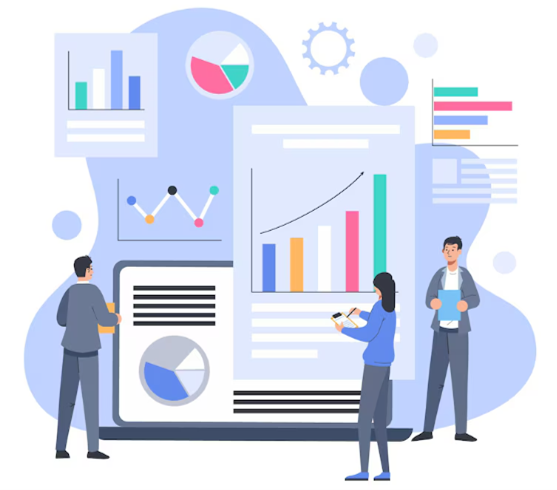Enhance Your HR Operations in 2025: Improving Decision-Making with the Reports & Analytics Module
.png)
The Evolving Role of Data in HR in Data Analytics
In today’s data-driven world, HR has stepped up from being just a support function to becoming a strategic powerhouse. Data isn’t just a behind-the-scenes asset anymore; it’s the foundation for proactive decision-making. With organizations now handling massive amounts of employee data, there’s a pressing need to leverage this information through smart reporting and analytics.

Understanding the Need for Reporting and Analytics in HR
Reporting and analytics give HR departments the insights they need to go beyond simple observation. Rather than just reacting to situations, HR leaders can dive into reports to spot trends, anticipate challenges, and make well-informed decisions regarding recruitment, performance management, and workforce planning.
Key Challenges in Analyzing Reports for HR Decision-Making
Even though it’s crucial, analyzing reports can be quite challenging. Issues like disconnected systems, isolated employee data, and a lack of analytical skills can really hold back data-driven decision-making. Without a cohesive platform, HR professionals often find it tough to pull actionable insights from scattered HR reports.
Importance of Real-Time HR Data Analytics
Real-time HR data analytics provides a major advantage by speeding up decision-making. It allows management to spot irregularities, track workforce trends, and take action quickly. With timely insights from a unified reporting and analytics system, HR operations can become more agile and responsive.
Core Functions of a Reports & Analytics Module
A solid Reports & Analytics module does so much more than just display dashboards. It offers dynamic visualizations, in-depth drill-down options, customizable HR reports, and a wide range of filters to help you slice and dice your data. This module centralizes access to performance metrics, employee data reports, and trend analyses, giving you a complete 360-degree view of HR.
Types of HR Reports That Drive Strategic Decisions
When it comes to HR reports, the variety is impressive, covering everything from headcount analysis to attrition forecasting and performance comparisons. Some key categories include:
- Workforce demographic reports
- Recruitment funnel metrics
- Training effectiveness assessments
- Absenteeism and attendance summaries
- Payroll compliance audits
Each report type contributes a unique perspective to the overall employee management framework.
Leveraging Employee Data Reports for Talent Management
Employee data reports act as a strategic tool for assessing the entire talent lifecycle—from onboarding to succession planning. These reports shine a light on productivity metrics, training needs, and skill gaps, allowing organizations to craft tailored employee development plans.
Boosting Employee Management with Analytical Dashboards
Dashboards take complex data and turn it into easy-to-understand visuals. HR managers can keep an eye on key performance indicators, spot areas that need improvement, and make better decisions throughout the employee management process. With the ability to filter, compare, and export analytics, HR professionals have complete control over workforce metrics.
Predictive Analytics in HR: Shaping Tomorrow's Workforce
Predictive analytics takes a look at past HR data and turns it into strategies for the future. By examining reports on previous behaviors, HR can predict turnover, pinpoint high-potential employees, and fine-tune hiring strategies. This forward-thinking approach leads to more strategic and proactive human resource management.
The Importance of Reports & Analytics in Policy and Compliance Monitoring
In today’s business world, compliance is a must. The Reports & Analytics module automates the tracking of company policies, benefits administration, and legal updates, ensuring that everything aligns with both organizational and legal requirements. By analyzing reports, businesses can anticipate risks and strengthen their governance.
Smooth Integration of Analytics with Digital HRMS
When paired with a robust platform like Digital HRMS, reporting and analytics reach their full potential. With centralized data access, automated updates, and role-based visibility, HR leaders can handle reports efficiently and transparently. This system makes sure that every metric becomes a valuable tool for decision-making.
Tangible Benefits of Analytics-Driven HR Operations
Implementing a reporting and analytics solution like Digital HRMS can lead to significant improvements:
- 35% faster decision-making
- 25% increase in HR productivity
- Better accuracy in forecasting and planning
- More efficient compliance tracking
- Enhanced employee engagement through targeted insights
Best Practices to Maximize the ROI of Reporting and Analytics
To truly tap into the potential of analytics, organizations should:
- Equip HR staff with the skills to interpret complex reports
- Set clear KPIs that align with the organization's goals
- Automate the scheduling of reports
- Ensure data synchronization across different modules
- Leverage analytics for employee feedback and strategic planning
Future-Proofing HR with Smart Analytics Tools
By 2025, the benchmark for HR excellence will shift from gut feelings to data-driven insights. Implementing a strong Reports & Analytics module will be key in transforming strategic human resource management. With Digital HRMS Reports & Analytics module, organizations can transition from merely collecting data to taking informed action—ensuring that every HR decision is timely, well-informed, and impactful.
Make Data Work for You – Explore Reports & Analytics with Digital HRMS Today! Ask for a free trial now.